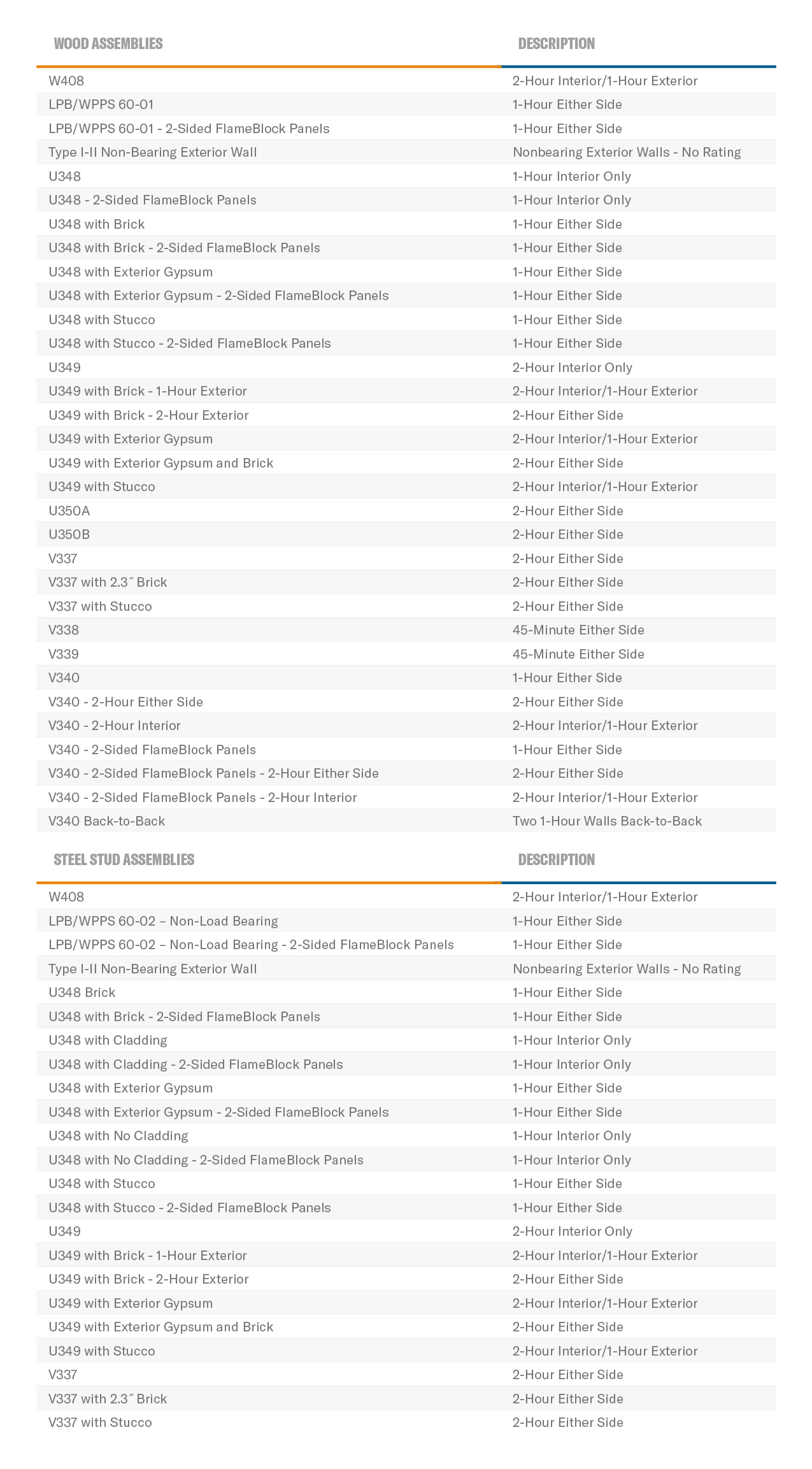Your Complete Guide to LP® FlameBlock® Flame-Resistant Assemblies
Meeting code is just one of the many versatile benefits of LP® FlameBlock® Fire-Rated Sheathing. Combining structural capacity and design flexibility, LP FlameBlock assemblies are evaluated to help meet code requirements for fire-resistance construction as a component of 1-hour and 2-hour wall assemblies and in roof deck applications.
LP FlameBlock sheathing may allow fire-resistance-rated walls to be assembled faster than common alternatives, so LP FlameBlock installation may help reduce labor costs while providing exceptional strength, durability and consistency.
While you may be familiar with the “original 8” UL and Intertek evaluated assemblies, LP Building Solutions has been adding additional assemblies to fit nearly all types of construction projects. Today, design professionals and architects have more than 30 LP FlameBlock fire-resistance-rated wall assemblies available for their projects.
Quick Q&A: LP FlameBlock Assemblies
Before we dive in, let's answer a few common questions:
Which LP FlameBlock fire ratings or fire-resistant wall assemblies should be used?
Before choosing among LP FlameBlock fire-resistance-rated wall assemblies, there are other elements that drive consideration. Load bearing or non-load bearing, type of construction, and occupancy category will dictate fire-resistance requirements.
What is 1-sided LP FlameBlock**?**
LP's proprietary non-combustible, fiberglass-reinforced Pyrotite® coating is added to one side of an OSB panel––which slows the effects of heat and flames.
When should one-hour over two-hour be selected?
“This is dictated by code,” says Scott Johnson, Construction Service Manager at LP Building Solutions. “Architects turn to the International Building Code (IBS), Chapter 6, which establishes construction time, such as Type III or Type IV construction.”
LP FlameBlock Assembly Highlights
Here are a few highlights of 2-sided and 1-sided LP FlameBlock assemblies for LP FlameBlock installation:
UL Design U349 assembly is configured for Type III exterior load-bearing walls. It is a 2-hour wall and is fire-rated from inside. May eliminate the need for exterior gypsum.
Only 2,3˝ brick is needed (not 3,4˝)
Evaluated for both wood and steel studs
Also available in a two-hour interior only assembly
UL Design V337 assembly is commonly used in Type III and V exterior load-bearing walls. It is a 2-hour wall and is fire-rated on both sides. Assemblies are also available with 2,3˝ brick and with stucco.
UL Design V340 assembly is configured for exterior load-bearing walls. It is a 1-hour wall and is fire-rated on both sides. UL Design may be used in these applications:
Single-family exterior walls along property line
Type V exterior walls with Fire-Rated Dampers (FSD) less than 10 feet
Type I, II and III non-bearing exterior walls with FSD less than 10 feet
Double 1-hour walls for townhouse construction
Back-to-back Type V fire walls to achieve 2-hour fire resistance in accordance with NFPA 221, Table 4,6

We have more solutions for increased fire-resistance performance. If your project has somewhat uncommon requirements, it's important to know there are many more LP FlameBlock assemblies listed under both UL and Intertek. Call LP at 615-610-1540 or your LP building solutions expert.
Continue Reading
Resiliency Solutions
5 minIntroducing LP® SmartSide® ExpertFinish® Naturals Collection™: Nature-Inspired Beauty Meets Engineered Performance
We're excited to introduce the LP® SmartSide® ExpertFinish® Naturals Collection™, a bold new addition to our trusted line of engineered wood siding and trim that delivers the warmth and beauty of nature with the advanced protection and performance builders and homeowners expect.
Labor Solutions
5 minChoosing the Right LP® Structural Solutions Product for Your Build
When it comes to building strong, reliable, and high-performing structures, the materials you choose matter. At LP Building Solutions, we understand that every project, whether it's a single-family home or a multifamily development, requires structural components that meet your needs for strength, durability, and efficiency.
Sustainability Solutions
5 minBuilding a More Sustainable Future with LP Building Solutions
In today's world, sustainability is no longer just a buzzword, it's a blueprint for responsible living and smarter building. As the construction industry seeks ways to reduce its environmental footprint, LP Building Solutions is focused on providing innovative building materials for eco-conscious builders to help reshape what it means to build sustainably
News & Stories3 min
History of Partnership with Gary Sinise Foundation
The LP Foundation is a proud partner of the Gary Sinise Foundation, which supports wounded veterans in several ways. You can learn more about the LP Foundation here.